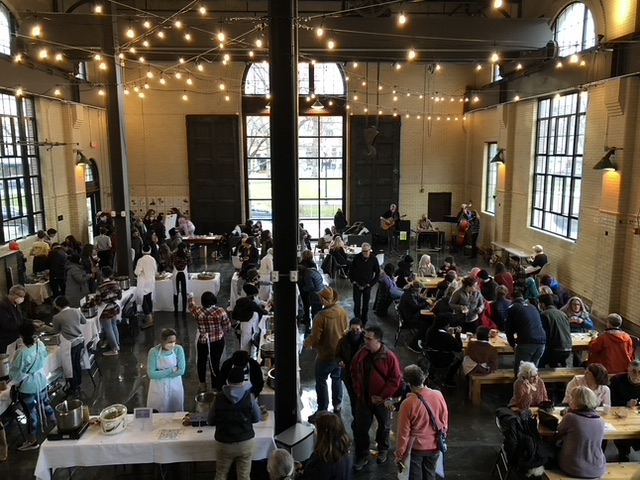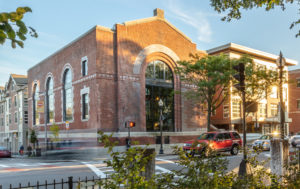
April 29, 2022 Roslindale Substation: Three Part Solution for a Historic Building
When Historic Boston and Roslindale Village Main Street found a partner, Peregrine Group of Rhode Island, to help them turn the stately but long neglected Roslindale MBTA former electrical substation into something cool, there were dreams of a chef-driven restaurant or arts space.
That was 2013. A lot has happened in nearly a decade since, but not that original vision. A craft beer store came and went on the lower floor. Trillium briefly occupied the cavernous but awe-inspiring upper hall, with its massive stained-glass window and restored industrial winch hook looming from above.

Before all that, of course, a solid brick structure that was a shambles inside, abandoned since the electrical power was no longer needed after 1971, had to be made habitable and even attractive. That happened.
The partners devised a clever plan to join the property with a funeral home property next door that was going out of business. Under a complicated agreement after the City of Boston made the substation property available for restoration and reuse, Peregrine turned the old funeral home into modern apartments and, as part of the deal, renovated the substation.
Since then, it’s been something of trial and error to marry an updated, worthy old building whose presence almost defines Roslindale Square with the economic realities of the day. Adam Rogoff, the local environmental lawyer who represented Roslindale Main Street, virtually adopted the property as his mission, working with the partners to discover the substation’s future.
You can read about the solution at The Substation website, thesubstation.space.
“It was never going to be a restaurant,” Rogoff told us recently, explaining that it became clear that the space was too much for one establishment. “We needed to find something else.”
The Trillium popup beer hall was a filler. The beer store downstairs worked well for a while, especially when people were flocking to taste the Trillium brews upstairs. After Trillium left, there were several iterations. Turtle Swamp took the upstairs for a time. Then the pandemic hit.
“What I learned with the building over the years was it needs multiple streams of income in order to work,” said Rogoff. “It couldn’t work solely was a beer hall several nights a week.”
Built in 1911, at 4228 Washington St., the corner of Cummins Highway and opposite Adams Park, the substation – branded now as The Substation – has now found life by serving three purposes.
The upstairs is a beer hall, continuing what Rogoff said was the “public embracing of the space” with rotating brands in a Brewer Residency Program. Brockton Beer was first, which happens to be one of the few Black-owned breweries in the Commonwealth. It opened April 8, having had temporary presences at other locations.
“They have New England IPAs, Double IPAs, but that’s not all they do,” said Rogoff. “They have a brewer with a lot of experience.”
A second leg of the three-legged Substation stool is co-working space, which continue to grow. “We happened on that accidentally,” said Rogoff. “We timed things right as the nature of work has changed. If people are not going back to the office 100 percent, they need an office near home.”
You know. A place near where the kids need to be picked up, or just a place to escape the house for a while and focus.
“It’s co-working during the week, and Friday we swap it out and it’s a beer hall,” Rogoff said. The Substation’s flexible furniture can accommodate laptops and survives a little beer being spilled on it at the end of the week.
And the third part of the answer to the question of “What to do with this great space?” involves events: popups, private events, weddings. “They are a large profit center for us.” And the income helps keep the space open to the public for nonprofit and donated uses.
Profit. A very welcome word when you’ve spent years trying out different uses and investing money in improvements to make one or another of them work.
The Commonwealth Circus Center troupes perform quarterly, making use of that heavy crane hanging from the steel beams. MusiConnects, a nonprofit music residency program in the area, uses The Substation’s excellent acoustics, dramatically improved by erasing echoes with application of thousands of dollars’ worth of sound materials to the ceiling.
Rozzie Bound, a cooperatively owned bookstore, shares the space too, opening on April 30, with up to 1,000 volumes. Roslindale Open Studios and artist’s openings will appear, as the word gets out.
“We’re trying to program it so it’s activated all the time,” said Rogoff, who even has his law office in the building now. He started out as a volunteer.
“Funny thing, I fell in love with it, and now I’m an entrepreneur,” he said. Like successful entrepreneurs, he tried multiple things till something worked. “If I’d thought about this a decade ago, I would have said no. But it worked because it was incremental.”
Rogoff brought on a staff person to help run the business, and now Laura Charles, a former interim executive director of Roslindale Main Streets, is his owner-partner and as Director of Community and Business Development programs the spaces.
The Substation donates space once a quarter to nonprofit causes. The first big one was for Empty Bowls, an anti-hunger group that raised money for food pantries by selling ceramic bowls and offering soups from 12 restaurants.
The schedule?
- Brockton Beer operates Fridays 4- 10 (starting at 3 p.m. for Workhub members) and Saturdays 12 to 10 p.m.
Friday. 4-10.
- Co-working is flexible. You can rent a conference room for as little as an hour or come work in the space for a half or full day 9-5 weekdays. Or have a half- or full-time membership, with 24/7 access. Part-time memberships start at $140 a month. There are private offices and conference rooms and common spaces, with the proverbial snacks. (See website for details.)
In addition, The Substation Gallery features local artists on a three-month rotating basis, currently the photography of Sebastian Viasus, and formerly housed an exhibit by Kathy Kottaridis, showcasing photographs from her @Sidewalk_Candy Instagram page.
Will The Substation endure and thrive? “The combination of the uniqueness of the building, a high level of activation, and the partners we have are capable of pulling it off,” said Rogoff, who has announced a May 12 grand opening and ribbon cutting.
“We’re celebrating the space, and we’re doing it in a way that will show off the diversity of the ways the building can be used,” he said.
If you’d like to know more about the Roslindale Substation…
The Roslindale substation redevelopment has received grants, awards, and other commendations, including from the Amelia Peabody Foundation, Henderson Foundation, Boston Preservation, and Preservation Massachusetts.
You can read an extensive feature on the substation in the National Trust for Historic Preservation’s Preservation Magazine here:
The substation was built in 1911 as part of a Boston network that powered trolleys of the Boston Elevated Railway, which preceded the MBTA. You can read a history of it here:
https://www.dropbox.com/s/p0lt5k6o0s01wom/Substation%20History%20Exhibit%20Final%20v2.pdf?dl=0
###



